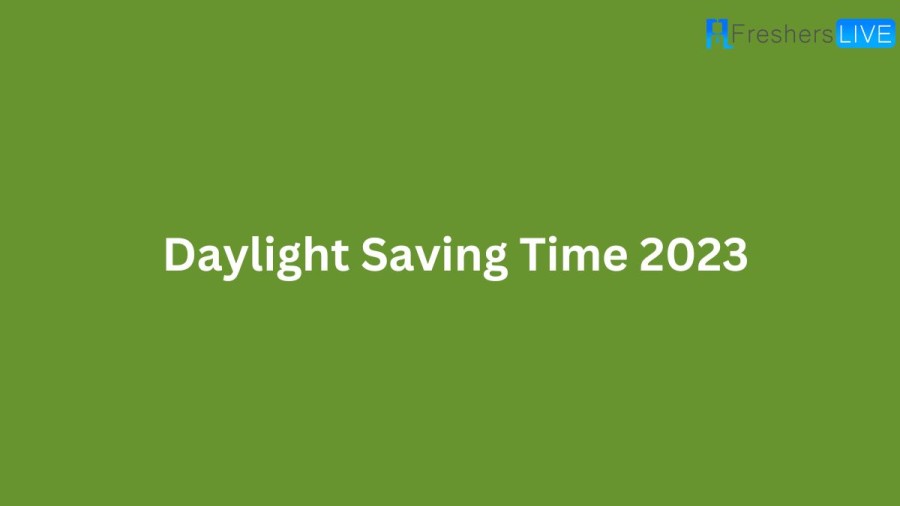Daylight Saving Time 2023, When is Daylight saving time?
by Venkatesh P
Updated Mar 16, 2023

Daylight Saving Time 2023
Daylight Saving Time (DST) is an age-old practice that has been observed in many countries around the world for over 100 years. In the United States, DST begins on the second Sunday in March and ends on the first Sunday in November. This article will cover everything you need to know about DST, including when it is, why it exists, how it works, and how to change your clocks.
When Is Daylight Saving Time?
In 2023, Daylight Saving Time will begin on Sunday, March 12, at 2:00 a.m. This means that clocks will be turned forward one hour, so 2:00 a.m. will become 3:00 a.m. local time. DST will end on Sunday, November 5, at 2:00 a.m. when clocks will be turned back one hour, so 2:00 a.m. will become 1:00 a.m. local time.
Reason For Daylight Saving Time
The main reason for DST is to make better use of the available daylight during the summer months. By advancing the clock by one hour during the summer, people can enjoy an extra hour of daylight in the evening. This is particularly beneficial for outdoor activities, such as sports and recreational activities, and can also help reduce energy consumption by reducing the need for lighting in the evening.
Why Does Daylight Saving Exist?
The concept of DST was first proposed by Benjamin Franklin in 1784 as a way to save on candle usage. However, it was not implemented on a large scale until the First World War when it was adopted by many countries to conserve coal. The practice was also adopted during the Second World War and was later standardized in the United States with the Uniform Time Act of 1966.
Daylight Saving Time Clocks
When DST begins, clocks are turned forward one hour, and when it ends, they are turned back one hour. This means that people can enjoy an extra hour of daylight in the summer and an extra hour of sleep in the winter. Most modern clocks, including those on smartphones and computers, will automatically adjust to DST. However, some older clocks, including those on appliances and cars, may need to be manually adjusted.
How To Change Daylight Saving Time?
If you need to manually adjust your clocks for DST, you should do so on the morning of the second Sunday in March and the first Sunday in November. Simply advance your clock by one hour when DST begins and turn it back by one hour when it ends. It is also a good idea to replace the batteries in your smoke detectors and carbon monoxide detectors when you change your clocks.
How Does Daylight Saving Time Work?
DST works by shifting the clock forward by one hour during the summer months to create an extra hour of daylight in the evening. This means that sunrise and sunset times are shifted by one hour, with the sun rising and setting later in the day. This is particularly beneficial for outdoor activities and can help reduce energy consumption by reducing the need for lighting in the evening.
Daylight Saving Time When?
As mentioned earlier, DST begins on the second Sunday in March and ends on the first Sunday in November in the United States. However, the start and end dates of DST can vary depending on the country or region. Some countries, such as Russia and Japan, do not observe DST, while others, such as Australia and Europe, have different start and end dates.
What Time Is Daylight Saving Time?
Daylight Saving Time (DST) is a practice of setting clocks ahead by one hour during summer months to extend daylight in the evenings. In the US, DST begins at 2:00 a.m. local time on the second Sunday in March and ends at 2:00 a.m. local time on the first Sunday in November. Some US states don't observe DST, and other countries have different dates or don't observe it.
Daylight Saving Time 2023 - FAQs
Daylight Saving Time (DST) is a practice of setting clocks forward by one hour during the summer months, typically from March to November, to extend the daylight hours in the evening.
The primary reason for observing DST is to make better use of the available daylight during the summer months, which can help reduce energy consumption and promote outdoor activities.
No, not all countries observe DST. Some countries, such as Russia and Japan, do not observe DST, while others, such as Australia and Europe, have different start and end dates.
Most modern clocks, including those on smartphones and computers, will automatically adjust to DST. However, some older clocks, including those on appliances and cars, may need to be manually adjusted by turning them forward or back by one hour.
In 2023, Daylight Saving Time will begin on Sunday, March 12, at 2:00 a.m. and end on Sunday, November 5, at 2:00 a.m. During DST, clocks are turned forward by one hour in the summer and back by one hour in the winter.







